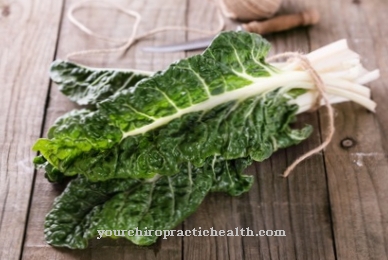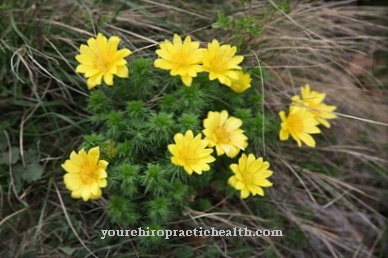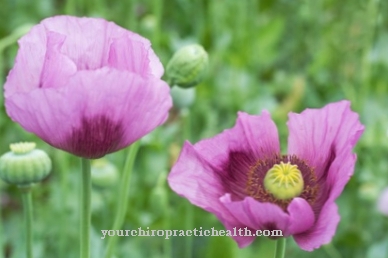Of the cumin, also Cumin or White caraway called, is a plant from the umbelliferae family. The dried fruits of the plant are used in the kitchen and in medicine.
Occurrence & cultivation of cumin

Cumin is an annual plant from the umbelliferae family. The plant is similar in appearance to the common caraway. It becomes about thirty to forty centimeters high and forms up to ten centimeters long leaves. Just like the leaves of fennel, these have leaf sheaths at their base and are divided into two to three fingers. The stems are not very hard, so the plant lacks stability for upright growth. It therefore grows in a creeping manner.
The flowers of the cumin are white to reddish in color and are arranged in four-pointed umbels. These are up to 2.5 cm wide and grow terminally. The flowering period of the cumin begins in June. The five millimeter long seeds develop in the small flowers around forty days after flowering. They are elongated and gray-green in color. As the fruit ripens, they become pale and split in half. The halves do not separate completely, but remain connected by a seed carrier. This creates a split fruit.
Effect & application
The main ingredients in cumin fruits are essential oils, fatty oils, resins and proteins. The essential oils of cumin in particular have an effect on the gastrointestinal tract. They have a digestive, appetizing, inflating, relaxing and pain relieving effect. The small fruits are also said to have an anti-inflammatory and antibacterial effect.
The cumin seeds can be used medicinally as a tea, tincture, herbal wine or powder.For a cumin tea, pour one to two teaspoons of lightly crushed cumin seeds with 250 ml of boiling water. The tea should steep for ten minutes. Alternatively, you can gently boil the seeds. For this, a teaspoon of the seeds is mixed with 250 ml of cold water. The water should slowly boil and then steep for a few minutes with the seeds. Then the tea can be strained. You can drink one to three cups of this cumin tea a day.
Areas of application for the tea are loss of appetite, intestinal cramps, biliary problems, colic, stomach cramps, irritable stomach or bloating. It is advisable to prepare a tea mixture of cumin seeds, fennel seeds and anise seeds, especially for complaints of the gastrointestinal tract. A three-week break should be taken after six weeks of continuous use at the latest. The tea can then be drunk again for six weeks.
The break prevents unwanted side effects and a habituation effect. A tincture of cumin can also be used to treat indigestion. For this purpose, the seeds are poured with clear schnapps in a sealable glass. The mixture should then continue to brew for two weeks. Then the tincture can be strained and poured into a dark bottle. Depending on the complaint, a daily intake of ten to fifty drops is recommended.
Cumin wine can be used to aid digestion and for fat digestion disorders. To do this, 100 grams of cumin seeds are mixed with one liter of white wine. This mixture is boiled, filtered and poured into a bottle. If necessary, a small glass should then be drunk. If you want, you can simply chew the seeds straight. This application can not only be helpful for stomach or intestinal problems, but also helps against bad breath.
The essential oil of cumin does not only have a positive effect on the digestive organs. It is also refreshing and invigorating. You can take advantage of this with a full bath. Simply put one liter of strong cumin tea in a full bath. The revitalizing bath refreshes and drives away tiredness.
Importance for health, treatment & prevention
Cumin has been valued as a medicinal and aromatic plant for thousands of years. In today's Syria, for example, there were three to four thousand year old kitchen scraps with cumin. In ancient Egypt, cumin was used in the kitchen as early as two thousand years before Christ. In ancient Rome, cumin was also a well-known and popular herb and medicinal plant. In Tibetan medicine, the plant is still one of the most important remedies today. Here, too, the plant is mainly used for stomach problems.
In many parts of the world, however, cumin is used more as a spice than as a medicinal plant. Thanks to its intense and unmistakable taste, it plays a role as a spice, especially in North African, Turkish, Greek, Iranian, Indian and Mexican cuisine. But the seeds are also used in culinary delights in the Netherlands. Cumin cheese is a well-known specialty here. Cumin is also part of the well-known Garam masala spice mixture and part of curry powder.
It is also found in spice mixes for chili con carne. Today, cumin can also be found in more and more German kitchens. As a medicinal plant, the cumin has so far not really caught on. Perhaps this is also due to the fact that the medicinal properties of cumin have not yet been confirmed by Commission E of the Federal Institute for Drugs and Medical Devices or by the European umbrella association of national societies for phytotherapy (ESCOP).





.jpg)





















